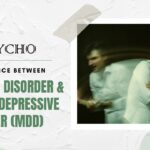Anxiety and mood disorders damage a person’s emotional health and capacity to function. Despite sharing certain indications and being found together, they are different. Anxiety disorders cause intense fear, concern, and dread. Anxiety disorders cause long-term anxiety triggered by particular situations, things, or thoughts. Anxiety disorders include GAD, panic, social, and particular anxieties. Anxiety episodes cause shaking, perspiration, a quick heartbeat, and difficulty sitting still. Anxiety disorders force people to worry too much about the future or potential risks, which makes them act in ways to avoid difficulty.
However, mood disorders are caused by emotional regulation and mood changes. MDD, bipolar, and dysthymia are covered. Mood disorders cause long-term mood changes. These mood alterations might vary from depression to mania or hypomania. However, mood disorders focus on the now rather than the future.
Their primary indicators and operation differ. Anxiety disorders cause excessive concern and physical symptoms. However, mental balance issues can induce long-term sadness or mania in mood disorders. Note that these categories don’t always exclude each other. Comorbidity—worry and mood issues—is common. Symptoms may overlap or mix, making it difficult to diagnose and treat.
Effective treatments differ for the two. Cognitive-behavioral therapy and selective serotonin reuptake inhibitors assist patients manage excessive worry and stress. However, mood disorders may require a combination of mood-stabilizing drugs (for bipolar disorder), antidepressants (for depression), and counseling to address mental dysregulation.
Anxiety and mood disorders are various mental health issues with different symptoms. Too much dread and concern generate anxiety disorders, whereas mental balance and mood issues cause mood disorders. Correct diagnosis and treatment can enhance mental health by recognizing these distinctions.
|
S. No. |
Aspect |
Anxiety Disorders |
Mood Disorders |
|
1 |
Core Emotion |
Excessive anxiety or fear |
Abnormal mood (e.g., depression) |
|
2 |
Emotional Focus |
Worries, apprehension, fear |
Sadness, elevated mood (mania) |
|
3 |
Primary Symptoms |
Mood-related symptoms |
|
|
4 |
Worry vs. Mood Episodes |
Worry is a dominant feature |
Mood episodes (depressive/ manic) |
|
5 |
Mood Episodes Included |
Not the primary feature |
Central feature of mood disorders |
|
6 |
Key Emotional Response |
Fear, apprehension, panic |
Sadness, euphoria, irritability |
|
7 |
Physical Symptoms |
Trembling, sweating, palpitations |
Changes in energy, sleep, appetite |
|
8 |
Core Focus |
Future-oriented concerns |
Present emotional state |
|
9 |
Triggers |
Stressors or anticipatory concerns |
Stressors, biochemical factors |
|
10 |
Flight-or-Fight Response |
Common and often heightened |
Present but not the primary focus |
|
11 |
Cognitive Distortions |
Catastrophic thinking, hypervigilance |
Negative cognitive patterns |
|
12 |
Core Fear |
Often involves specific phobias |
Absence of a specific fear |
|
13 |
Medication Management |
Antidepressants, anxiolytics |
Antidepressants, mood stabilizers |
|
14 |
Impact on Behavior |
Often avoidance behaviors |
Affective changes in behavior |
|
15 |
Focus on Physical Sensations |
Heightened during anxiety |
Present but not the primary focus |
|
16 |
Panic Attacks |
Common in anxiety disorders |
Can occur in mood disorders |
|
17 |
Neurotransmitter Involvement |
Dysregulation of GABA, serotonin, norepinephrine |
Dysregulation of serotonin, norepinephrine, dopamine |
|
18 |
Focus on Threats |
Often exaggerated or irrational |
Not the primary focus |
|
19 |
Cognitive-Behavioral Interventions |
Effective in addressing anxiety |
Used for managing mood episodes |
|
20 |
Social Anxiety |
Often involves fear of judgment |
May involve social withdrawal |
|
21 |
Psychomotor Restlessness |
Can be present but not dominant |
May be seen in manic episodes |
|
22 |
Mood Lability |
Less pronounced |
More prominent in mood disorders |
|
23 |
Response to Positive Events |
Reduced positive response |
Elevation of mood (mania) |
|
24 |
GAD (Generalized Anxiety Disorder) |
Widespread and persistent worry |
Absence of expansive mood (mania) |
|
25 |
Onset Age |
Often earlier in life |
Can vary with different disorders |
|
26 |
Cognitive Changes |
Exaggerated focus on threat |
Negative cognitive patterns |
|
27 |
Diagnostic Criteria |
Specific criteria for anxiety disorders |
Specific criteria for mood disorders |
|
28 |
Emotional Regulation |
Often involves excessive worry |
Involves changes in mood |
|
29 |
Panic Disorder |
Characterized by panic attacks |
Absence of panic as a central feature |
|
30 |
Obsessive-Compulsive Disorder |
Characterized by obsessions, compulsions |
Not a defining feature of mood disorders |
|
31 |
Elevation of Mood |
Absent |
Present in manic episodes |
|
32 |
Duration of Symptoms |
Variable; chronic or episodic |
Episodic, with varying duration |
|
33 |
Agitation and Restlessness |
Present in certain anxiety disorders |
Prominent in manic episodes |
|
34 |
Depersonalization or Derealization |
May occur during panic attacks |
Not a defining feature of mood disorders |
|
35 |
Mood Stabilizers |
Not the primary focus |
Used for managing mood episodes |
|
36 |
Neuroimaging Findings |
Brain changes related to anxiety disorders |
Brain changes associated with mood disorders |
|
37 |
Affective Reactivity |
Reactive emotional response |
Altered emotional reactivity |
|
38 |
Social Avoidance |
Can be present but not primary |
Often seen in depressive episodes |
|
39 |
Substance Use |
May be used to cope with anxiety |
Can be used as a maladaptive coping strategy |
|
40 |
Anhedonia (Lack of Pleasure) |
Often less pronounced |
Central feature in depression |
|
41 |
Impact on Decision-Making |
Often driven by worry and uncertainty |
Often impaired due to depressed mood |
|
42 |
Biological Rhythms |
Can lead to sleep disturbances |
Disturbances in sleep and appetite |
|
43 |
Impact on Cognitive Functioning |
Impaired concentration and focus |
Reduced cognitive processing |
|
44 |
Medication Side Effects |
Can vary based on medication type |
Can vary based on medication type |
|
45 |
Therapeutic Approaches |
Exposure therapy, relaxation techniques |
Psychotherapy, medication management |
Frequently Asked Questions (FAQS)
Q1. What differentiates stress from anxiety?
Anxiety and stress are related yet distinct. Stress is a transitory response to external stressors. Anxiety, on the other hand, is intense concern and terror without a clear reason. After stress is gone, anxiety might cause anxiousness or a quick heartbeat.
Q2. Can children get mental illnesses?
Kids can have mood issues. Mental health professionals know about childhood depression and bipolar illness. Mood-disordered kids may feel unhappy or angry all the time, have difficulties sleeping or eating, and struggle in school and with friends. Mood-challenged kids require immediate and proper care.
Q3. What's the difference between shyness and social anxiety disorder?
Shyness is not a social anxiety disorder. Shy persons are uncomfortable in social situations. However, social anxiety disorder involves a concern about being observed or judged by others. This condition can cause discomfort and make life difficult for those who shun social situations. Therapy helps address the underlying anxieties and find solutions.
Q4. How can I help a friend who is suffering from a worry disorder?
Helping a buddy with anxiety requires empathy, understanding, and patience. Listen without criticizing, provide expert aid, and understand as much as you can about their circumstances. Invite them to meetings if they feel secure. Respect their boundaries and feelings. Remember that you are helping, not replacing expert care.
Q5. Do mood fluctuations mean bipolar disorder?
Bipolar illness can cause mood fluctuations, but not always. Mania and sadness are the hallmarks of bipolar disorder. Strong, long-lasting mood fluctuations make daily living difficult. A mental health practitioner can assess and treat excessive mood swings.









